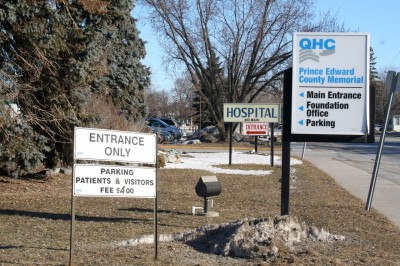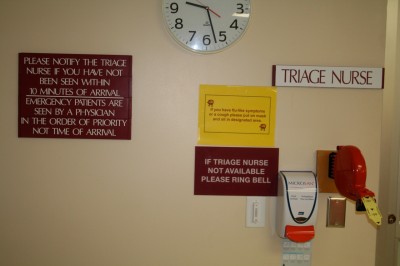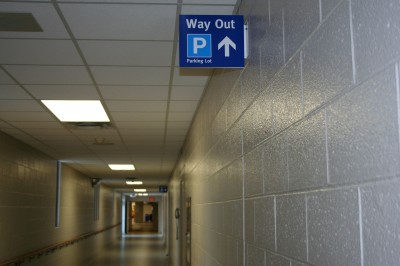By Peter Saunders
Quinte Health Care (QHC), which manages four hospitals in Eastern Ontario, recently developed a strategy to renew its facilities with improved indoor and outdoor signage. This ongoing project is seen as an opportunity both to improve wayfinding for each hospital and to unify all of them under the QHC banner.
The organization runs Belleville General Hospital, Trenton Memorial Hospital, Prince Edward County Memorial Hospital and North Hastings Hospital. Together, these facilities employ approximately 1,600 staff and 280 physicians, serving up to 255 inpatients at a time and more than 300,000 outpatients every year. They house emergency departments, operating rooms, ambulatory care clinics, a daytime rehabilitation facility, a children’s treatment centre, mental-health programs and a range of diagnostic services.
Belleville’s is the largest of the sites and presented a particularly immediate concern, as visitors were confused and many temporary signs had been posted during various department moves and continuous renovations.
“There have been a lot of changes at Belleville over the years, but we haven’t updated our wayfinding signs and people are often getting lost,” community relations director Susan Rowe told The Intelligencer before the project began. “A lot of people coming to the hospital are elderly or have mobility issues. We want to make their experience as comfortable and easy as possible.”

Quinte Health Care manages four hospitals in Eastern Ontario, all of which will be renewed with improved outdoor and indoor signage.
Another issue was visitors could find themselves on the first, second or third floor upon arriving at the hospital, depending on which entrance they used.
So, QHC sought the advice of professional wayfinding consultants to help develop a new system. A request for service (RFS) for the public-tender project was posted in early 2011, calling for expert consideration of sign design, placement, colours and wording, particularly with accessibility in mind.
Selecting a strategy
Ottawa-based DMC Designs, which had experience with hospital wayfinding, was selected to help develop the new sign strategy.
“I had submitted the proposal myself and it went directly to QHC, whereas in most cases I have to work as a subcontractor to engineering and construction firms,” explains Daniel McClinton, DMC’s senior sign designer and wayfinding consultant. “They required lots of written theory.”
McClinton’s educational background was in industrial design. He began his career in the mid-1980s as a sign designer for the now-defunct Canadian Government Expositions Centre (CGEC) in Ottawa, where his responsibilities involved implementing the Federal Identity Program (FIP), including the Canada wordmark. This work gave him experience with the fundamentals of wayfinding and sign design.

At Belleville General Hospital, Quinte Health Care’s largest site, many temporary signs had been posted during various department moves and renovations, leading to confusion for visitors.
Indeed, the term ‘wayfinding’ was still somewhat in its infancy when McClinton worked with renowned graphic designer Paul Arthur’s team, collaborating on a new corporate identity for Canada Post within the FIP system. The writings of both Arthur and wayfinding researcher Romedi Passini helped McClinton develop a further awareness of the principles of effective wayfinding.
When he sent his proposal to QHC, he had recently worked with two major Ottawa health-care facilities: Élisabeth Bruyère Hospital and Saint-Vincent Hospital.
“I had heard about the QHC project in late 2010,” he says. “I sent along my proposal in early 2011 and, a week or two later, I was in.”






